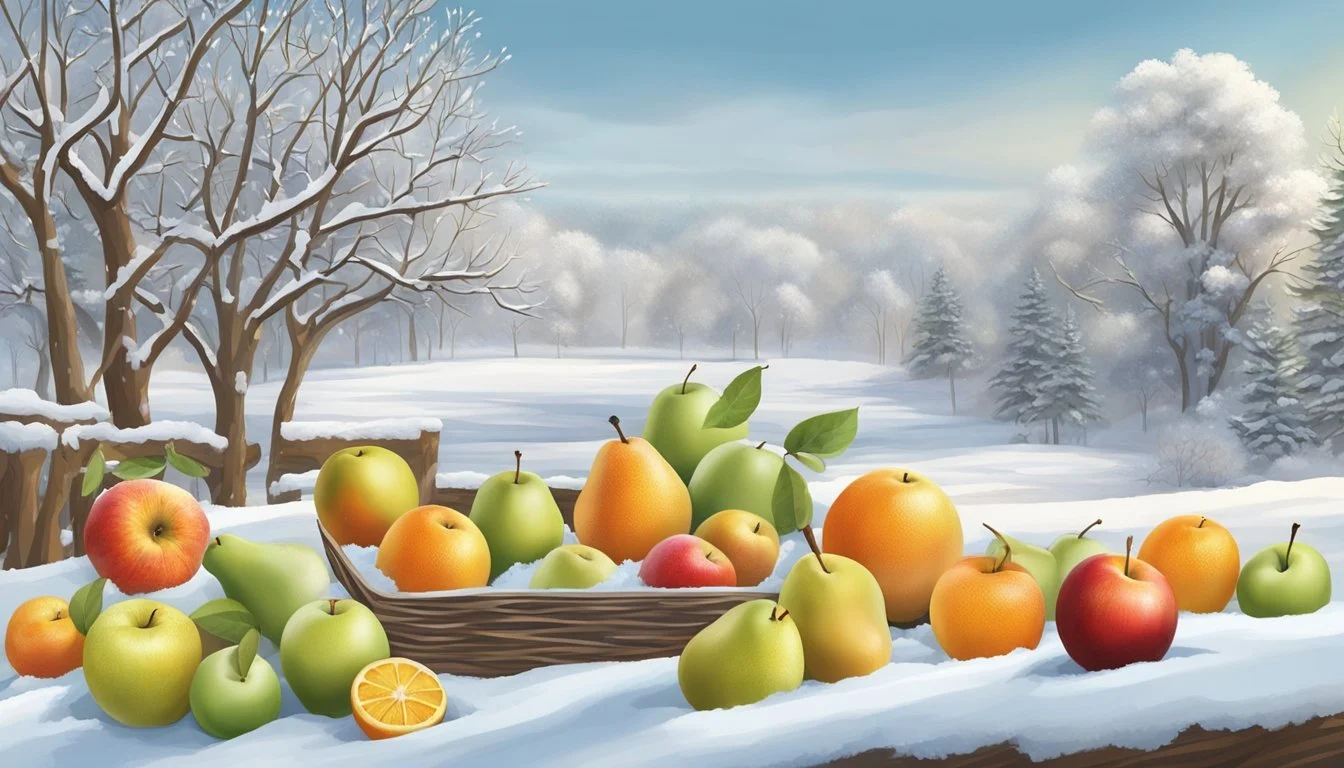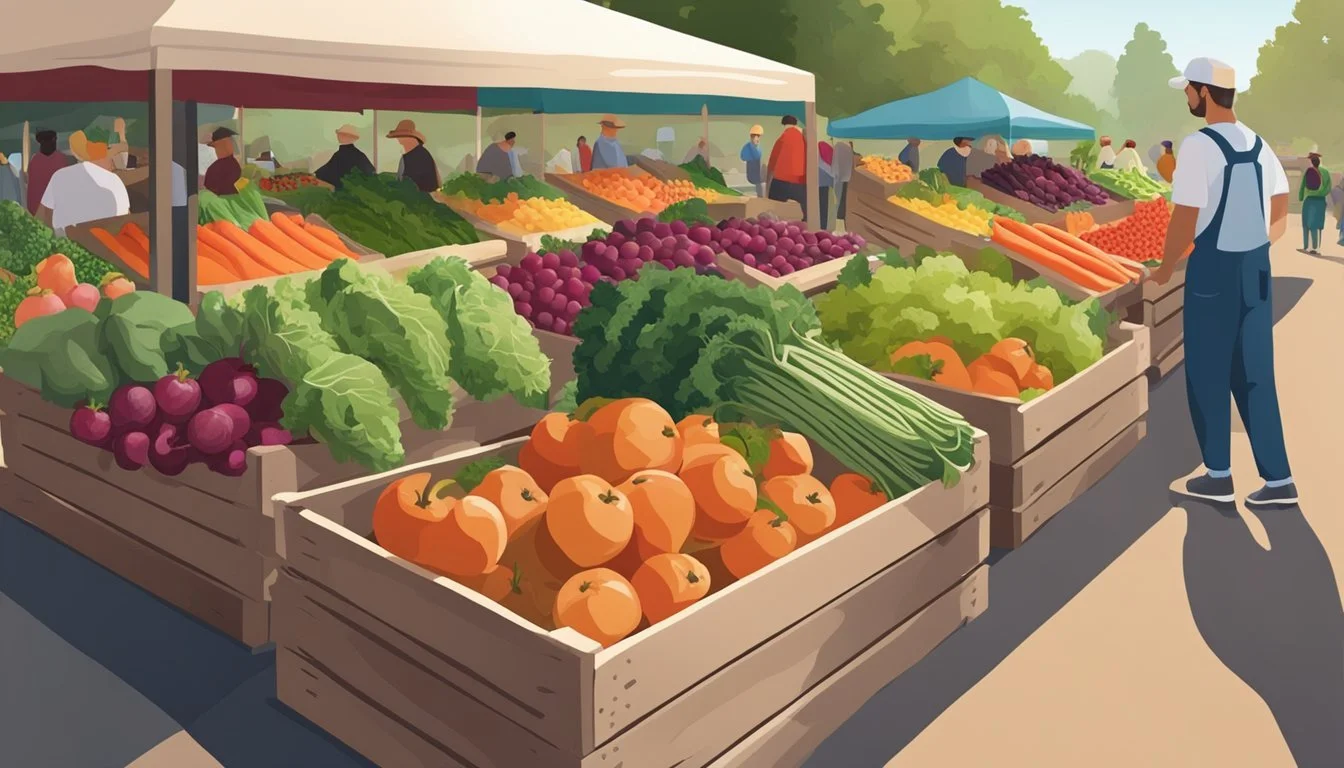Pennsylvania Seasonal Fruit & Vegetables in February
A Guide to Winter Produce
This Article is Part of our Pennsylvania Seasonal Fruit & Veg Calendar
Pennsylvania, known for its diverse climate and fertile soil, offers a range of seasonal fruits and vegetables, even during the colder month of February. During this time, gardeners and consumers alike can still enjoy a variety of fresh produce. The state's agriculture benefits from the cold weather to yield hardy vegetables well-suited to the chill of winter, as well as storing the last season's harvest of particular fruits.
Vegetables such as lettuce thrive in February's cool temperatures, making it an ideal time to plant and consume them in Pennsylvania. With proper care, these winter crops can withstand frost and snow, ensuring a steady supply of fresh greens. At the same time, Pennsylvania's storage facilities continue to supply fruits like apples, which were harvested in the fall and kept in cold storage to maintain their freshness through the winter months.
Aside from freshly grown produce, February also offers residents the chance to savor preserved or stored varieties of fruits and vegetables. This period highlights the importance and convenience of seasonal eating, encouraging the consumption of available fresh produce, which supports local farmers and reduces the carbon footprint associated with long-distance transportation of food items.
Benefits of Seasonal Eating
Seasonal eating involves selecting fruits and vegetables that are naturally at the peak of their supply and can be procured locally, both of which offer various benefits:
Flavor: Produce that has been grown and harvested in its appropriate season possesses a richer flavor compared to out-of-season or imported varieties. Consumers often find that seasonal fruits and vegetables taste fresher and more flavorful.
Nutrients: Seasonal produce is likely to be fresher and, therefore, higher in nutritional value. Fruits and vegetables begin to lose their nutrients soon after they are picked, so the shorter the time between the farm and your table, the less likely that nutrient loss has occurred.
Freshness: Buying produce that is in season ensures a higher degree of freshness since these items are sold soon after harvest. This not only contributes to optimal taste but also to the longevity of the produce when stored at home.
Seasonal Produce Chart for Pennsylvania:
Winter Months Fruits Available Vegetables Available December-February Apples (cold storage) Root vegetables (e.g., beets) Cabbages Winter squash
Eating seasonally supports the body's nutritional needs for that time of year. In winter, for example, root vegetables and cabbages are rich in nutrients that support a healthy immune system, which is essential during colder months.
In conclusion, seasonal eating in Pennsylvania maximizes the benefits of freshness, flavor, and nutrient content, while also aligning with the body's natural nutritional requirements.
Understanding Pennsylvania's Seasonality
Pennsylvania's climate and seasonal shifts play a crucial role in determining the availability and quality of its produce.
Pennsylvania's February Climate Impact on Produce
In Pennsylvania, February is squarely within the winter season. It brings cold temperatures and, often, snow, which significantly influences the types of produce available. The state's farmers are limited to what can be stored from fall or grown in colder conditions.
Most of the fresh produce during this month comprises root vegetables and hardy winter greens, as well as stored fruits and vegetables from previous seasons. Here's a breakdown:
Vegetables:
Root vegetables like beets and carrots, which are resistant to colder temperatures, are typically available.
Storage crops such as potatoes, onions, (What wine goes well with onions?) and cabbages persist from previous months.
Fruits:
Fresh fruits are scarce; however, stores of apples harvested in the fall remain prevalent.
Greenhouses:
Some farmers use greenhouses to grow produce like lettuce and herbs, circumventing the harsh outdoor conditions.
Overall, the cold weather in February significantly reduces the variety of fresh seasonal produce in Pennsylvania. Cold storage and greenhouse growing practices help provide some fresh options during these winter months.
Seasonal Fruits Available in February
Pennsylvania offers a limited but distinct selection of fruits in February. These seasonal choices provide fresh flavors despite the cold weather.
Citrus Fruits
During February, citrus fruits become a prominent feature in the local produce offerings. These include a variety of oranges, tangy lemons, and the striking blood oranges. Known for their vibrant color and sweet-tart flavor, blood oranges are a seasonal delight.
Oranges: Full of Vitamin C, perfect for winter immunity.
Lemons: Versatile for cooking and rich in antioxidants.
Blood Oranges: Notable for their deep red flesh, offering a unique taste compared to regular oranges.
Storage Apples and Pears
Apples and pears harvested in the fall are kept in cold storage to extend their availability into the winter months. Shoppers can expect to find crisp storage apples and juicy pears as part of Pennsylvania's February bounty.
Apples: Varieties might include favorites like Fuji or Gala, known for their longevity in storage.
Pears: These often retain their quality well, making them a good choice for fresh eating or cooking.
Exotic Fruits
Although not locally grown, exotic fruits often make their way to Pennsylvania markets and can provide a tropical taste amidst the winter season. Availability can vary, but they offer an interesting addition to the local diet.
Exotic Fruits: Look out for fruits such as kiwi or pomegranate to add diversity to winter fruit options.
Seasonal Vegetables Available in February
In February, Pennsylvania's produce selection highlights hardy seasonal vegetables that withstand the cold winter months. Shoppers can expect to find a variety of root vegetables, cruciferous vegetables, and leafy greens that are at their peak during this time.
Root Vegetables
Pennsylvania's February climate nurtures a selection of root vegetables known for their robust flavors and versatility in the kitchen. Shoppers will find an abundance of:
Potatoes: A staple in many households, perfect for mashing, baking or roasting.
Onions: Essential for flavoring a multitude of dishes, from soups to sautés.
Parsnips: Providing a sweet, nutty profile to hearty winter meals.
Turnips: Excellent when roasted or added to stews.
Celery Root (Celeriac): With a subtle flavor ideal for soups and purees.
Cruciferous Vegetables
Cruciferous vegetables thrive in the chill of Pennsylvania's winter, providing excellent nutrition and flavor:
Cabbage: Comes in several varieties and is ideal for fermenting into sauerkraut or used fresh in slaws.
Kale: Known for its nutritional value, kale adds a hearty element to salads, soups, and chips.
Leafy Greens
Even in the cold winter months, some leafy greens remain in season, perfectly complementing the hearty fare of the season with their fresh flavors:
Leeks: A relative of onions, their milder taste is perfect for enhancing soups and potato dishes.
Choosing and Storing February Produce
In Pennsylvania, February's chill calls for proper selection and storage of limited fresh produce to maintain flavor and nutrition. Consumers should choose fresh vegetables and fruits that are firm and free from blemishes or soft spots, which can indicate spoilage.
For vegetables like cabbage and brussels sprouts (how long do brussels sprouts last?), selecting heads that are dense and heavy for their size will usually yield the best flavor. When it comes to fruit, storage is crucial to preserve freshness. Apples, a durable winter fruit, should be stored in a cool, dark place or in the refrigerator crisper to prolong their shelf life.
Root vegetables such as beets can be stored in a cool, dark place as well; they often retain their freshness for several weeks. When properly stored in a refrigerator, they maintain their crisp texture, while their earthy flavor remains intact, perfect for both raw and cooked applications.
Here is a quick reference guide for storing common produce available in February:
Produce Storage Method Shelf Life Apples Refrigerator 4-6 weeks Cabbage Cool, humid area/refrigerator 3-4 weeks Brussels Sprouts Refrigerator 3-4 weeks Beets Cool, dark place/refrigerator 2-3 weeks
Freezing can be an option for brussels sprouts and cabbage to extend their usability beyond their fresh shelf life. Blanching them prior to freezing helps preserve their quality. For fruits like apples, canning is an age-old method to enjoy their flavor throughout the year. Ensuring that all produce is thoroughly cleaned and dried before any form of storage is essential to prevent mold growth and spoilage.
Seasonal Recipes for Winter Produce
In February, Pennsylvania’s winter produce offers hearty vegetables and vibrant fruits that are perfect for creating nourishing meals. Utilizing seasonal ingredients not only supports local agriculture but also ensures that dishes are infused with the freshest flavors.
Seasonal Fruits: For a wholesome breakfast or a sweet side dish, one might utilize February fruits such as apples and blood oranges. Apple Cinnamon Oatmeal or a Citrus Salad with blood oranges can start the day with a burst of energy.
Vegetable Side Dishes: Broccoli (how long does broccoli last?) and Brussels sprouts are versatile vegetables suitable for a variety of side dishes. One could prepare Roasted Broccoli with Lemon Zest (how long does lemon zest last?) for a simple yet flavorful addition to any meal. Alternatively, Sautéed Brussels Sprouts with Garlic make for a savory appetizer that's both delicious and simple to make.
Recipe Type Main Ingredients Apple Cinnamon Oatmeal Breakfast/Side Dish Apples, Oats (how long do oats last?), Cinnamon Citrus Salad Side Dish/Appetizer Blood Oranges, Mixed Greens, Vinaigrette Roasted Broccoli with Lemon Zest Side Dish Broccoli, Lemon, Olive Oil Sautéed Brussels Sprouts with Garlic Appetizer/Side Dish Brussels Sprouts, Garlic, Butter
Hearty Root Vegetables: Beets, available from June through December, can still grace the February table. A recipe such as Beetroot and Feta Salad provides a colorful and nutritious option that serves as an excellent side dish.
They should remember that hearty winter produce can be transformed into an array of delightful recipes that celebrate the season. Each recipe allows for a creative and tasteful experience of Pennsylvania’s winter bounty.
Local Farming and Community Support
In Pennsylvania, the interplay between local farmers and the community notably strengthens during February, as the state’s seasonal shift prompts a lean on resources that bolster regional agriculture. Farmers across the Commonwealth offer Community Supported Agriculture (CSA) programs, creating a symbiotic relationship where consumers support local agriculture while receiving fresh, seasonal produce.
CSA Programs: A Snapshot
Structure: Consumers purchase "shares" from local farms, entitling them to a portion of the season's harvest.
Content: Shares typically include a variety of vegetables, with the possibility of other farm products.
Benefits: Provides upfront income to farmers; reduces economic risk; fosters community-farmer connections.
By participating in CSAs, community members actively contribute to the sustainability of local farms, ensuring that they are able to weather the difficulties of the farming season. This practice emphasizes the importance of seasonal produce, reaffirming the state's commitment to agricultural health and local consumption.
Furthermore, Pennsylvania’s agricultural department encourages communities to engage with local producers. Whether by visiting farms or attending markets, individuals can support local agriculture—a crucial economic driver in the state. This dedicated support also counters the trend towards long-distance food sourcing, reducing environmental impacts associated with transport.
Local initiatives serve as an education platform, teaching Pennsylvanians how to best utilize in-season crops such as winter squash and hearty greens, which mature well even in cooler temperatures. They not only provide nourishment but also help maintain the state's agricultural diversity and heritage.
Seasonal Eating Tips and Tricks
February in Pennsylvania challenges individuals to think differently about seasonal produce due to limited fresh local options. They often turn to preserved, stored, or greenhouse-grown produce.
When considering peak season, one must understand that options are generally restricted. Root vegetables and hearty winter greens usually remain in good condition through cold storage or late harvesting. Residents can expect to find goods like potatoes, turnips, and onions.
For those interested in gardening, they should use this period for planning. One can start seeds indoors for vegetables such as tomatoes and peppers to transplant after the last frost.
Buying guides become essential as they help determine the freshness and quality of winter produce. Consumers should look for firmness in root vegetables and avoid any with soft spots or sprouting. Here’s a condensed list of produce one might find and their signs of freshness:
Produce Freshness Sign Potatoes Firm, no green spots Onions Dry outer skin, no sprouting Winter Greens Crisp leaves, vibrant color
Consumers may also take advantage of year-round greenhouse crops like lettuces and herbs that maintain consistent quality. Additionally, preserved fruits and vegetables from the previous harvest can be an excellent way to enjoy out-of-season favorites.
People shopping for produce should aim to support local farmers' markets or subscribe to a CSA (Community Supported Agriculture) box, which often includes winter crops and value-added products like jams, syrups, or pickled vegetables. (What wine goes well with pickled vegetables?)
By understanding what is realistically available and employing strategic purchasing and pre-planning for the garden, they can navigate the challenge of seasonal eating in February with confidence.
Monthly Seasonal Produce Calendar
In the context of Pennsylvania's seasonal offerings during February, one finds a limited, yet distinct, variety of fresh produce. The chill of winter demands robust crops, capable of withstanding cooler temperatures. As such, residents and culinary enthusiasts may take solace in hearty root vegetables and an array of cold-tolerant greens.
Vegetables:
Root Vegetables: Carrots, onions, and potatoes are steadfast through the winter months, sustaining their quality and availability.
Leafy Greens: Options such as kale and collards continue to thrive, delivering nutrient-rich choices for salads and cooked dishes.
Others: Some produce like Brussels sprouts and leeks also remain in season, rounding out the winter vegetable palette.
February's produce calendar indicates a leaner period prior to the arrival of early spring's bounty. As March approaches, individuals can anticipate the first inklings of a new harvest cycle. By April, the soil begins to yield a greater diversity, introducing spring onions and radishes to the market. May then marks a substantial transition, where a medley of fruits and vegetables, spearheaded by the likes of asparagus and rhubarb, signal the full stride of spring.
It is in these cycles that consumers find opportunities to support local agriculture by aligning their purchases with the seasonal calendar. This practice ensures peak freshness and quality, while fostering sustainability within the community's food systems.











